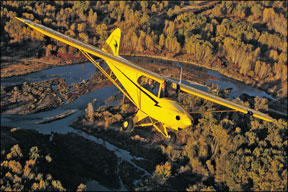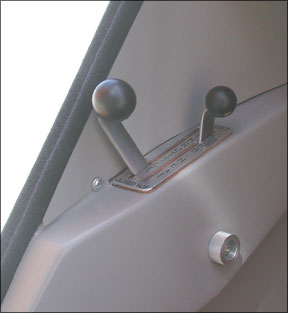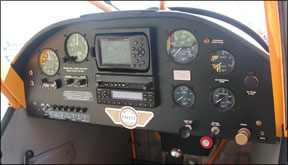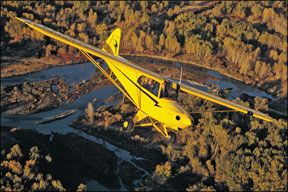Hows this for the ultimate incongruity: Bose headset, full glass panel, electric trim and a Garmin GPSmap 496 with NEXRAD and TIS traffic, all slipped into the front end of a Cub with quite a lot of room to spare. Although were sure William T. Piper could never have imagined it, thats exactly where we are in the brave new world of emerging light sport aircraft. If the original LSA concept included as much as a passing nod to simple and unsophisticated, the reality may be anything but. Not that were complaining. Over the years, weve paid periodic homage to that which William T. wrought, the venerable yellow J-3 Cub. Were doing it again in this issue, with a revised 
In the meantime, we recently examined both aircraft and compared them in brief flight demonstrations. For our purposes, the overarching question is this: You can buy a real Cub for about a third of the cost of a new CubCrafters or Legends LSA version. So why do these guys think they can sell reheats of the old design, when something like 5500 of the original 14,125 Cubs are still out there, churning through the used market? Two answers: One is the lure of new. Some buyers simply want factory fresh airplanes. Period. Second, a substantial number of LSA buyers don’t know the yellow Cub mystique from a cow pie, they just want a cool little airplane. Thats what William Piper figured out 70 years ago and its still true today. Only the numbers have changed.
Two Approaches
Were calling these airplane Cub clones, but thats a misnomer of sorts. The only thing cloned is the Cub mystique-the airplanes themselves represent substantial departures from the original. In fact, CubCrafters, the longer-established of the two companies, is highlighting the differences between its Sport Cub and the original. American Legends, on the other hand, produces model variants that look and feel like the original, but have significant improvement in engines, avionics, construction and safety features.
CubCrafters was established by Jim Richmond in 1980, primarily as a Super Cub rebuild shop, for which it earned a respected reputation. When Piper ended PA-18 Super Cub production in 1994, CubCrafters took up the slack by building its own Super Cubs and it eventually morphed this into a FAR 23 version of the Super Cub that it calls the Top Cub.
The Top Cub is a fully certified, genuine working airplane with a 180-HP Lycoming O-360 and a gross weight of 2300 pounds with a maximum useful load of 1100 pounds. Its a player for bush and utility operators who want a new working airplane with a Super Cubs performance.
Building on that experience and anticipating the arrival of LSA rules, CubCrafters developed what it called Cub Light, a PA-18-95 Super Cub with a 100-HP Continental O-200. It weighed 930 pounds empty, a bit fatter than the 890-pound LSA limit. Rather than trim down the Cub Light for an LSA entrant, CubCrafters used the original J-3 as a reference for a clean sheet design, rethinking the idea to modern build and safety standards, but still meeting the LSA weight limits. (Worth noting is that Pipers original E-2, F-2, J-2 and J-3 models meet the LSA limits, if unmodified.) CubCrafters Sport Cub has a base price of $99,500.
American Legend Aircraft has taken a different tack, having formed in 2005 for the purpose of building sport fun-to-fly aircraft but, like CubCrafters, with a sideline in rag-and-tube restoration in Cubs and other types. Legend builds one LSA-certified model, but in three variants, starting at a base price of $84,785. (Look for that to increase by about 8 percent by the time you read this.) The AL3C-100 has an open cowl, with the O-200 cylinders in the airstream, like the original Cub. The AL11C-10 has the same O-200, but with a closed cowl and the AL11J-120 has a 120-HP Jabiru engine.
Old But New

If a rag-and-tube airplane can be said to be modern, we suppose both the Sport Cub and Legend are as modern as its possible to be. Both companies have bettered the original Piper idea and the improvements are more than skin deep. The Sport Cub, for instance, is 4 inches wider than the J-3 and has an adjustable fore-and-aft seat. The panel is also further forward, giving an interior feel more like a Decathlon than an original Cub, whose cramped, difficult-to-enter front seat was one of the designs glaring weaknesses. To further address this, the cabin side door is 20 percent larger and is, of course, openable in all phases of flight. To improve the underlying construction, CubCrafters uses welded 4130 throughout, with powder-coat corrosion proofing and select use of carbon fiber for weight and strength. The cowling, airbox, wingtip bows, side stringers, spinner, floorboards and front seat are composite.
The Sport Cub retains the basic cable-operated Cub flight control system, but the tail feathers are dimensionally larger than the J-3 and is had a balanced elevator. And like the Super Cub, the Sport Cub has flaps, manually operated via an overhead ratcheted lever accessible from the front seat, from which the airplane can be soloed.

The trim system retains Pipers jackscrew-adjusted horizontal stabilizer, but it has only electric trim, not manual. The biggest safety improvements are well-anchored four-point harnesses and no fuel in the cabin. Standard fuel capacity is 12 gallons in a Super Cub-style wing root tank and there’s an option for an additional 12 gallons in the opposite wing, which Clay Hammond told us will soon be standard. Gauging is via sight tubes in the wing roots. There’s only one engine option, the 100-HP Continental O-200 with a 12-amp lightweight alternator and a 30-amp alternator for the flight panel option.
Although we had no need to try it, the Sport Cub has a cabin heater. Vortex generators are also standard.
As would be expected, the standard panel is spare with an airspeed indicator, altimeter, compass, engine instruments and inclinometer, plus an SL40 comm. Less expected, perhaps, is the option of a Dynon FlightDEK D-180 EFIS, a Garmin GTX 327 or 330 transponder and Bose headsets. The version we flew was so equipped and specd out $131,380.
By comparison, Legend has hewn more to the look of the original Cub, if not the underlying construction. It too is wider than the old Cub-by 3 inches-but rather than a single right-side cabin door, it has a clamshell door on each side, a nice improvement. Legends Kurt Sehnert showed us some of the improvements on a bare bones frame at Sun n Fun.
He explained that each of the Legends frame tubes are precisely cut on a CNC machine, including notches for the tube joints, which are TIG rather than gas welded. The insides of the tubes are sprayed with Corrosion X and, post welding, the entire frame is coated with epoxy rust protection.

Throughout the airframe, there are subtle changes or improvements over the old Cub frame. For example, above the pilots head, there’s a stiff X-bracing that Sehnert says gives the cabin more crash integrity and in the wings, he pointed out square-tube truss members that replace the old-style tensioned wire in the original Cub. That means washout can be set in the wing jig, not eyeballed once the airplane is assembled. Although you don’t see it, most Cubs have a square of fabric cut out of the lower fuselage to provide maintenance access to the trim jackscrew. Legend anticipated this and installed a removable aluminum access panel in lieu of the slit fabric method.
Like the Sport Cub, the Legend offers various panel options, ranging from steam gauges to a mega-equipped version with the Dynon EFIS, graphic engine monitor, transponder, SL40 comm and a Garmin GPSmap 496 in an Air Gizmo mount. With the top-of-the-line panel, the Legend retails for about $115,000, pre-price increase.
Flight Impressions
No surprise, both airplanes fly like Cubs. However, the Legend is decidedly more like the original, at least in the open cylinder version we flew. And thats to say the CubCrafter version is, in our view, a little easier to manage on the ground by dint of having toe brakes rather than the Legends original heel brakes. Grizzled taildragger veterans may say brakes are what get you into trouble in a tailwheel airplane, but they can also get you out of it and, in any case, you still need them. But even the heel brakes are a skill acquired with practice; the toe brakes simply come more naturally. Both have enough visibility from the front seat to taxi without S-turns.
Along with the brakes, the Legend retains the Cub quirk of having the mag switch above the pilots head in the wing root and it has the old window crank trim weve come to know and love. With its electric-only trim-not our favorite, thanks-and mags-on-the-panel setup, the CubCrafters Sport Cub nods more to Vero Beach, less to Lock Haven. Takeoffs in these airplanes are utterly Cub-like, which means power up, stick forward, then back to levitate off the runway, followed by the unrestrained reaction of a full-molar grin. With only 100 HP, climb rates arent exactly stellar, but then whats the hurry? Both are good short/soft field performers, leaping off the runway in under 300 feet. The Sport Cubs flaps may improve this, but not enough to matter much in the way the airplanes will be used.
Cruise speeds are just fast enough to go somewhere at a 90 to 105 MPH slow pace, but not to go far unless you have a lot of time. The Sport Cub seemed a bit faster, by dint of the closed cowl, but climb rates were similar. Stalls are non-events, especially in the Sport Cub, which has vortex generators to keep airflow attached at high angles of attack. (VGs are an option for the Legend.)
But there’s a dark side. The original Cub had a horrible stall accident record, largely because its open-door flying capability lured pilots into flying at treetop level and in steep banks, from which an inadvertent stall is unrecoverable. Both the Legend and CubCrafter redos use the same Clark Y/USA35B airfoil and although VGs may give both an edge, low-level turning stalls arent to be trifled with.
Landings, of course, are the center of satisfaction for taildragger pilots and both of these airplanes are sufficiently challenging to make mastering them a worthy goal. With its three-position flaps, the Sport Cub behaves more like a Super Cub than a J-3.
Flap deployment gives a noticeable pitch-up moment that needs to be trimmed off to achieve a comfortable 60 MPH approach speed. With flaps down, the Sport Cubs descent angle may be a little steeper than the Legends, but the difference isn’t marked. We tended to fly approaches in both too high because of the airplanes talent for effortless gliding. Side slips are a useful skill. Touchdowns are wheelies or three pointers. Done right, theyre among the sweetest rewards in aviation. But for the slow of foot and hand, a docile Cub can turn nasty in the blink of an eye.
Conclusion
So, which of these to recommend? Were getting ahead of ourselves. Frankly, were still in wait-and-watch mode with regard to the entire LSA market. Maybe it will bloom, maybe it wont. Of all the LSA contenders, CubCrafters appears to be the most established, having been around for nearly 30 years, and it reports having delivered about 25 Sport Cubs, a number that may suggest a market with legs.
But Legend is no slouch and has delivered about 90 of its Cubs, which also looks promising to us, even if the company is a new startup in a field notorious for business failures. For the time being, we think a buyer enthralled with the nostalgia of the Cub mystique would do better with the Legend model. Its just more true to the original. If a more genteel, modernized taildragger appeals, we would go with the Sport Cub. And if Cubs just don’t do it for you at all, stick around. The LSA market will have plenty to pick from.


